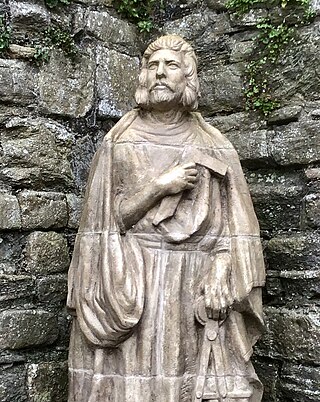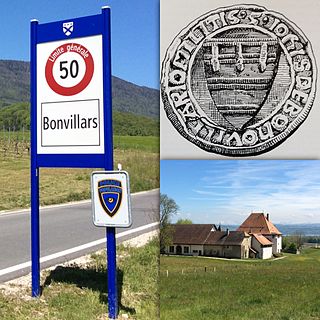
Amadeus V was Count of Savoy from 1285 to 1323.

Master James of Saint George was a master of works/architect from Savoy, described by historian Marc Morris as "one of the greatest architects of the European Middle Ages". He was largely responsible for designing King Edward I's castles in North Wales, including Conwy, Harlech and Caernarfon and Beaumaris on Anglesey.
Andrew Moray, also known as Andrew de Moray, Andrew of Moray, or Andrew Murray, was an esquire, who became one of Scotland's war-leaders during the First Scottish War of Independence. Moray, heir to an influential north Scotland baron, initially raised a small band of supporters at Avoch Castle in early summer 1297 to fight King Edward I of England, and soon had successfully regained control of the north for the absent Scots king, John Balliol. He subsequently merged his army with that of William Wallace, and jointly led the combined army to victory at the Battle of Stirling Bridge on 11 September 1297. Moray was mortally wounded in the fighting at Stirling, dying at an unknown date and place that year.

The now-extinct title of Earl of Richmond was created many times in the Peerage of England. The earldom of Richmond was initially held by various Breton nobles; sometimes the holder was the Breton duke himself, including one member of the cadet branch of the French Capetian dynasty. The historical ties between the Duchy of Brittany and this English earldom were maintained ceremonially by the Breton dukes even after England ceased to recognize the Breton dukes as earls of England and those dukes rendered homage to the King of France, rather than the English crown. It was then held either by members of the English royal families of Plantagenet and Tudor, or English nobles closely associated with the English crown. It was eventually merged into the English crown during the reign of Henry VII of England and has been recreated as a Dukedom.

Caldicot Castle is an extensive stone medieval castle in the town of Caldicot, Monmouthshire, in southeast Wales, built near the site of Harold Godwinson's former Saxon castle by the Norman earls of Hereford from about 1100. The castle became a Grade I listed building on 10 June 1953.
Sir James OrmondaliasButler was the son of John Butler, 6th Earl of Ormond. He was Lord Treasurer of Ireland from 1492 to 1494, and helped to defend the Lordship of Ireland against the forces of Perkin Warbeck. He was murdered by Sir Piers Butler on 17 July 1497. Piers would later hold the title of Earl of Ormond.

The title Baron of Loughmoe is an Irish feudal barony located in northern County Tipperary, Ireland. It was first held by Richard Purcell but the lands and castle were actually secured by Hugh Purcell of Loughmoe, first lord of Loughmoe. The title was possibly raised to a Jacobite peerage in 1690 while James II was in exile, Marquis de Ruvigny notes this in his 'The Jacobite Peerage, Baronetage, Knightage and Grants of Honour' Click here for link. The feudal title was granted to Richard Purcell in 1328 by James Butler, 1st Earl of Ormond as palatine Lord of Tipperary. Irish and Scottish feudal titles, particularly those granted by palatine lords, are difficult to classify in law, they are acknowledged as genuine hereditaments by the arms granting bodies of Ireland, Scotland, and England, but were never formally recognized by the Crown.

Otto de Grandson, sometimes numbered Otto I to distinguish him from later members of his family with the same name, was the most prominent of the Savoyard knights in the service of King Edward I of England, to whom he was the closest personal friend and many of whose interests he shared.
Maud de Lacy, Baroness Geneville was a Norman-Irish noblewoman and wealthy heiress who inherited half the estates of her grandfather Walter de Lacy, Lord of Meath, upon his death in 1241. The lordships of Trim and Ludlow passed to her second husband Sir Geoffrey de Geneville, 1st Baron Geneville by right of his marriage to her; although she helped to rule and administer the estates in an equal partnership. She is sometimes referred to as Matilda de Lacy.

Amadeus III was the Count of Geneva from 1320 until his death. He ruled the Genevois, but not the city of Geneva proper, and it was during his time that the term "Genevois" came to be used as it is today. He was the eldest son and successor of William III and Agnes, daughter of Amadeus V of Savoy. He played a major rôle in the politics of the House of Savoy, serving consecutively as regent and president of the council, and also sitting on the feudal tribunal—one of three tribunals of the Audiences générales—of the Duchy of Aosta.

Louis I was the Baron of Vaud. At the time of his birth he was a younger son of the House of Savoy, but through a series of deaths and his own effective military service, he succeeded in creating a semi-independent principality in the pays de Vaud by 1286. He travelled widely in the highest circles of European nobility, obtained the right to mint coins from the Holy Roman Emperor, and convoked the first public assembly in the Piedmont to include members of the non-noble classes. When he died, his barony was inherited by his son.

Grandson Castle is a medieval castle in the Swiss municipality of Grandson in the canton of Vaud. It is a Swiss heritage site of national significance.

Geoffrey de Geneville, 1st Baron Geneville also known as Geoffrey de Joinville and Geoffroi de Joinville, was an Anglo-French noble, supporter of Henry III, who appointed him Baron of Trim, County Meath, and, subsequently, a staunch supporter of Edward I.

Sir John de Bonvillars (c. ?–1287) was a medieval Savoyard knight in the service of Edward I. He was the brother in law of Otto de Grandson, and like William de Cicon, had been introduced to English service by Otto.

Edward I of England was associated with a faction of nobles and knights who came from the County of Savoy, and were favoured in England. Savoy became linked to the Plantaganet monarchy of England with the marriage of Edward I's parents Henry III of England and Eleanor of Provence in 1236. Eleanor of Provence was the daughter of Beatrice of Savoy.

Ebulo de Montibus Born as a younger son of Ebal I de Mont and his wife, Beatrice, Ebal II was first noted in 1237. Born in the Pays de Vaud, now Switzerland then Savoy. The Famille de Mont held the castle at Mont-le-Grand near Rolle. Better known in English records as Ebulo de Montibus, Ebal II de Mont had travelled to England by 1246. A household knight of King Henry III of England, granted much land in England. By 1256 he was part of the Savoyard circle of the Lord Edward, later King Edward I of England. Recorded as a Steward in the household of King Henry III of England from 12 November 1256 until 26 May 1263. A witness for King Henry III at the Mise of Amiens, where he swore for the king's good conduct in accepting King Louis XIVs arbitration. Left England during the Second Barons' War with Queen Eleanor of Provence and Peter II, Count of Savoy and active in attempting to raise an army loyal to the crown. Rewarded for his loyalty by being made Constable of Windsor Castle.

Pierre de Champvent was a noble originally from Savoy who made a career as a military and courtier in England.

William of Champvent or Guillaume de Champvent was the son of Henri, Lord of Champvent, brother of Othon de Champvent and Pierre de Champvent, cousin of Otto de Grandson. He followed Peter II, Count of Savoy to England and served King Henry III of England as a diplomat. His church career in England, being a dean of St. Martin's Le Grand in London from 1262. His influence at court in 1262 is evidenced by his joining the Savoyard witness list for a charter relating to Queen Alianor’s dowry. Upon his departure back to Lausanne Edward I of England would appoint Louis I of Vaud to St. Martin's Le Grand

Peter of Geneva or Pierre de Genève was the son of Humbert de Genève, Count of Geneva and grandson of William I.


















